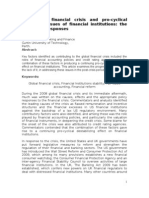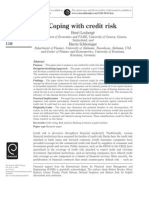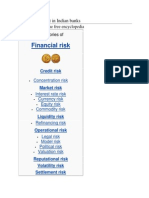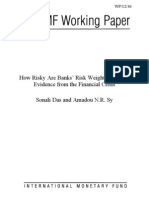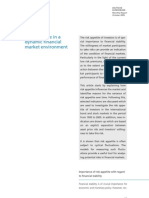Literature Review
Literature Review
Uploaded by
kictoddCopyright:
Available Formats
Literature Review
Literature Review
Uploaded by
kictoddOriginal Description:
Copyright
Available Formats
Share this document
Did you find this document useful?
Is this content inappropriate?
Copyright:
Available Formats
Literature Review
Literature Review
Uploaded by
kictoddCopyright:
Available Formats
Literature Review
The goal of risk management at the central bank is to improve the efficiency of the execution of
monetary policy, and in some cases, financial supervision, and to facilitate the optimal allocation
of the national foreign exchange reserves. This risk management framework is usually developed
in line with best market practices (Sangmanee and Raengkhum, 2!.
Risks to which central banks are exposed can be categori"ed as financial and non#financial risks.
$n the context of the central bank, financial risks arise from managing the national foreign
reserve and exposure to financial market operations while non#financial risks arise from bank
operations and the execution of monetary policy.
%hile central banks usually have &uantifiable risk management frameworks to monitor financial
risks, non#financial risks are no less important. %hile the main focus of the study will generally
be about the financial risk that faces the balance sheet, reputational risk will be discussed as it
remains the greatest threat to the central bank's international credibility. (entral banks are
typically exposed to a variety of risks. )s its reputation is vital to properly execute the functions
of a central banks, their risk appetites have traditionally been relatively low. (entral banks, given
their role within the financial system tend to be risk averse. (onse&uently, as technology and
model techni&ues continue to advance, central banks are now benefiting from risk management
techni&ues that arise from more conscious assessment of the risks. *any (entral banks integrate
risk management framework to ensure consistency on all levels.
The central bank's balance sheet is useful in clarifying the various transmission channels. (aruana (2++!
focused on the specific risks related to the balance sheet. )ny accumulation of assets implies an increase
in corresponding liabilities. $n addition, the purchase of domestic assets will directly affect their prices,
and therefore credit spreads term premia and long term interest rates. )n increase in monetary liabilities,
for example, reserve money, will have implications for li&uidity of the banking sector in the short run, and
this may undermine the price stability in the medium term. ,ut an increase in long term liabilities could
also crowd out lending to the private sector. Taking into account these transmission channels, it is &uite
clear that large expansions of central bank balance sheets have implications both for financial and non#
financial sectors of the economy.Sangmanee and Raengkhum (2++! noted that the central bank in
Thailand, clearly defined benchmarks are used. so that any deviation from the target can be
detected. The risk tolerance level is embedded in the benchmark through the risk ad-usted target.
They assessed asset#liability, li&uidity and investment portfolio using the value#at#risk method to
capture the relevant market risk and to create a common unit of risk measurement.
.ugee (+//0!, states that from a risk control viewpoint, the most obvious feature of a central bank's
balance sheet is that it carries unavoidable currency risks as the ma-ority of the liabilities are in domestic
currency. $n addition, to currency risk central banks face unavoidable interest rate risks as most he
liabilities are floating rate. (entral banks have used its balance sheet to play a salient role in
financial history especially during crises. )s such they are given a monopoly on note issuance
and the role of lender of last resort. ,agehot (as cited in (aruana, 2++! clearly understood this
privileged position vis#1#vis the rest of the financial sector in the +/th century. 2uring times of
financial distress, only the central bank could be a credible lender of last resort. $ts ability to
create monetary liabilities could be used to provide li&uid assets to a bank in difficulty. $t is
because of this vital role, central banks expand their balance sheet to meet these unexpected
events, while seeking to maintain its ultimate ob-ective of price stability.
Risks on balance sheets of central banks have significantly increased since the start of the 20#
23 financial crisis, with potential negative conse&uences for the financial system. 4nhanced
li&uidity provision, relaxation of collateral rules, and si"able asset purchases have led to
increases in the absolute si"e of central bank balances sheets, an increase in the duration and
diversity of assets, and a decline in asset &uality. These changes pose risks, valuation changes as
a result of changes in interest rates. These could result in the decline in operating income when
central banks increase their holdings of long#dated securities in addition topossible impairment
losses on assets with credit risk .The extent to which the various central banks are exposed to
these risks differs, depending on the scope and nature of their policies.
The global expansion of central bank balance sheet is exceptional. (entral banks have showed
competence in using their balance sheet to prevent crisis. This expansion of their balance sheet
means that it becomes more exposed to market developments such as a fall in the value of
foreign assets or a rise in long term interest rates, which could reduce the value of their assets
while leaving the value of their liabilities intact exposing the central bank to both market and
credit risk.
5ilardo and 6etman (2+2! states that the use of central bank balance sheets to effect change
creates a number of policy risks such as the negative effects of inflation on interest rates and
price stability. *oreover, it poses a risk to financial stability with possibilities of market
distortion. 7e also argued, however, that because the materialisation of such risks is not
inevitable, prudence dictates caution and vigilance.
)n increase in the bank's local currency assets, which is a ma-or counterpart of the increase in
the foreign currency reserves, can lead to excessive credit expansion, since there seems to be
some correlation between credit growth and foreign exchange accumulation. )n analysis by
(ook and 6etman (2+2! argues that there is growing evidence of incomplete sterilisation which
reinforces credit risk in the market. The threat to financial stability from an increase in bank
lending is greater when credit growth is already robust and inflation pressure is picking up.
5ilardo 8 9renville (2+2! state that large balance sheets leave central banks vulnerable to large
financial losseswhich impact the central bank's return on its foreign assets as reserves may yield
less than the costs of central bank bills and the interest rate paid on excess reserves.
5inally, (hen et al, (2+2! explored the similarities and differences in risks to the balance sheet
for different financial institutions. They examined four financial ratios: capital, leverage, asset
li&uidity and funding. These ratios would measure the risks to the balance sheet for the financial
institution. They also discuss how these risks have evolved over the decades and describe
relevant development in the banking sector regulation that could have contributed to the
observed change. This paper will adopt these risk indicators, in addition to foreign exchange and
interest rate risk indicators. These indicators were chosen because they are not complex and can
be easily compiled from the information presented on the ,;<'s balance sheet.
You might also like
- Truss Full ReportDocument23 pagesTruss Full ReportMoganraj90% (136)
- Stress Testing For Bangladesh Private Commercial BanksDocument11 pagesStress Testing For Bangladesh Private Commercial Banksrubayee100% (1)
- Fundamental Stress Testing Procedure For PrivateDocument7 pagesFundamental Stress Testing Procedure For Privatebaudelaires_icarusNo ratings yet
- Occasional Paper Series: The Use of Portfolio Credit Risk Models in Central BanksDocument45 pagesOccasional Paper Series: The Use of Portfolio Credit Risk Models in Central BanksDejChonlateeNo ratings yet
- Ijcb 24 Q 3 A 8Document82 pagesIjcb 24 Q 3 A 84jzqgwshgfNo ratings yet
- 1 s2.0 S0378426604002456 MainDocument27 pages1 s2.0 S0378426604002456 MainYaseen KhanNo ratings yet
- The Role of Banks' Capital in Economic Policy MakingDocument3 pagesThe Role of Banks' Capital in Economic Policy MakingbidomiNo ratings yet
- The Global Financial Crisis and Pro-Cyclical Instability Issues of Financial Institutions: The Post-Crisis ResponsesDocument9 pagesThe Global Financial Crisis and Pro-Cyclical Instability Issues of Financial Institutions: The Post-Crisis ResponsesfahadaijazNo ratings yet
- Using The Exposure Based Cash Flow at Risk Approach To Estimate The Liquidity Risk: An Application For The Indonesian BanksDocument22 pagesUsing The Exposure Based Cash Flow at Risk Approach To Estimate The Liquidity Risk: An Application For The Indonesian BanksSetiawan SetiawanNo ratings yet
- ssrn-1370826Document33 pagesssrn-1370826rvelesNo ratings yet
- Risk Management in Commercial BanksDocument6 pagesRisk Management in Commercial BanksAman AgarwalNo ratings yet
- Risk Management in Banking CompaniesDocument2 pagesRisk Management in Banking CompaniesPrashanth NaraenNo ratings yet
- MPRA Paper 28672Document40 pagesMPRA Paper 28672ajinkyan2000No ratings yet
- Conventional and Insidious Macroeconomic Balance-Sheet CrisesDocument40 pagesConventional and Insidious Macroeconomic Balance-Sheet CrisesAdminAliNo ratings yet
- Long Term Bank Lending and The TransferDocument55 pagesLong Term Bank Lending and The TransferFerdee FerdNo ratings yet
- Martín Redrado: The Central Bank of Argentina Passed The TestDocument2 pagesMartín Redrado: The Central Bank of Argentina Passed The TestChetan ChitreNo ratings yet
- Biah422 Assignment 1Document10 pagesBiah422 Assignment 1Simba MashiriNo ratings yet
- Coping - With Credit RiskDocument17 pagesCoping - With Credit RiskShatarupa MitraNo ratings yet
- Risk Management Strategies of FinanDocument15 pagesRisk Management Strategies of Finanpossess1289No ratings yet
- Risk Management in Indian BanksDocument20 pagesRisk Management in Indian BanksDinesh Godhani100% (1)
- Risk-Taking Behavior and Trend Analysis of The Ethiopian Banking Sector: An Observation of Selected BanksDocument9 pagesRisk-Taking Behavior and Trend Analysis of The Ethiopian Banking Sector: An Observation of Selected BanksInternational Journal of Innovative Science and Research TechnologyNo ratings yet
- Leung, W. S., Taylor, N., & Evans, K. P. (2015) .Document17 pagesLeung, W. S., Taylor, N., & Evans, K. P. (2015) .Vita NataliaNo ratings yet
- Stress Tests A Policymakers PerspectiveDocument12 pagesStress Tests A Policymakers PerspectiveHao WangNo ratings yet
- Impact of Liquidity On Bank ProfitabilitDocument14 pagesImpact of Liquidity On Bank ProfitabilitRam Raj GautamNo ratings yet
- Capital Adequacy: Team Fly PresentsDocument4 pagesCapital Adequacy: Team Fly PresentsHryshikesh DihingiaNo ratings yet
- SSRN Id2060753Document22 pagesSSRN Id2060753rajuNo ratings yet
- The Belgian Macroprudential Policy Framework in The Banking SectorDocument20 pagesThe Belgian Macroprudential Policy Framework in The Banking SectorVictoria PostolacheNo ratings yet
- RISK IN THE BANKING SYSTEMDocument32 pagesRISK IN THE BANKING SYSTEMnicoleNo ratings yet
- 1-s2.0-S1572308908000144-mainDocument32 pages1-s2.0-S1572308908000144-mainminhhoa221001No ratings yet
- CH 2Document22 pagesCH 2XUAN DIAONo ratings yet
- Chapter-I Introduction and Design of The StudyDocument28 pagesChapter-I Introduction and Design of The StudyShabreen SultanaNo ratings yet
- Systemic Risk in Financial ServicesDocument106 pagesSystemic Risk in Financial ServicesadeepjainNo ratings yet
- Dynamic Maturity TransformationDocument51 pagesDynamic Maturity Transformationvidovdan9852No ratings yet
- Dynamic Pricing of Svgn Risk in EM, Fundamentals and Risk AversionDocument28 pagesDynamic Pricing of Svgn Risk in EM, Fundamentals and Risk AversionDavid MalisNo ratings yet
- The Need For Minimum Capital Requirement: spl/gjfmv6n8 - 12 PDFDocument36 pagesThe Need For Minimum Capital Requirement: spl/gjfmv6n8 - 12 PDFMaitreyeeNo ratings yet
- Calon 1Document58 pagesCalon 1alfirafresdiNo ratings yet
- Country risk factors and banking sector stabilityDocument22 pagesCountry risk factors and banking sector stabilityMeriem HedhliNo ratings yet
- Risk Management in Banks Under Basel NormsDocument53 pagesRisk Management in Banks Under Basel NormsSahni SahniNo ratings yet
- rdp1999 09Document57 pagesrdp1999 09reachernieNo ratings yet
- Does Monetary Policy Affect Bank Risk-Taking?: Centre For Banking and Financial Studies, Bangor UniversityDocument46 pagesDoes Monetary Policy Affect Bank Risk-Taking?: Centre For Banking and Financial Studies, Bangor Universitydungtran0989No ratings yet
- Asset Liability Management: in BanksDocument44 pagesAsset Liability Management: in Bankssachin21singhNo ratings yet
- 6647 21647 1 PBDocument26 pages6647 21647 1 PBngocNo ratings yet
- Research 3Document40 pagesResearch 3ms.AhmedNo ratings yet
- Oct 2023 GFSR Chapter 2Document26 pagesOct 2023 GFSR Chapter 2jenna.amber000No ratings yet
- Nouveau Document Microsoft Word (15) - CopieDocument7 pagesNouveau Document Microsoft Word (15) - CopiemangreNo ratings yet
- The Journal of Finance - 2015 - BEHN - Procyclical Capital Regulation and LendingDocument38 pagesThe Journal of Finance - 2015 - BEHN - Procyclical Capital Regulation and LendingIssabella SonneNo ratings yet
- Finance and Economics Discussion Series Divisions of Research & Statistics and Monetary Affairs Federal Reserve Board, Washington, D.CDocument30 pagesFinance and Economics Discussion Series Divisions of Research & Statistics and Monetary Affairs Federal Reserve Board, Washington, D.CTBP_Think_TankNo ratings yet
- Eco 2021 02Document70 pagesEco 2021 02sanfredomunthe04No ratings yet
- ssm.2022 Letter On Leveraged Transactions - enDocument21 pagesssm.2022 Letter On Leveraged Transactions - enericbn77No ratings yet
- Portfolio Analysis Banking SectorDocument40 pagesPortfolio Analysis Banking SectorMaster RajharshNo ratings yet
- Regulation of Financial Markets Take Home ExamDocument22 pagesRegulation of Financial Markets Take Home ExamBrandon TeeNo ratings yet
- Global Financial Crisis and Key Risks: Impact On India and AsiaDocument27 pagesGlobal Financial Crisis and Key Risks: Impact On India and AsiahemantNo ratings yet
- SR 690Document44 pagesSR 690desta yolandaNo ratings yet
- How Risky Are Banks' Risk Weighted Assets? Evidence From The Financial Crisis Sonali Das and Amadou N.R. SyDocument38 pagesHow Risky Are Banks' Risk Weighted Assets? Evidence From The Financial Crisis Sonali Das and Amadou N.R. SyKostas GeorgioyNo ratings yet
- Loan or Meet Contractual Obligations. Traditionally, It Refers To The Risk That A LenderDocument3 pagesLoan or Meet Contractual Obligations. Traditionally, It Refers To The Risk That A LenderReicaNo ratings yet
- Ijcb13q3a6 OkaDocument46 pagesIjcb13q3a6 OkayaoNo ratings yet
- Measuring Sovereign Risk in Peripheral Euro Area Countries With Contingent Claim Models: A Comparison With Traditional IndicatorsDocument38 pagesMeasuring Sovereign Risk in Peripheral Euro Area Countries With Contingent Claim Models: A Comparison With Traditional IndicatorsNayyabNo ratings yet
- Bundesbank Risk PaperDocument13 pagesBundesbank Risk PaperJohn HuttonNo ratings yet
- 07 GenbergDocument14 pages07 GenbergJayanthi KandhaadaiNo ratings yet
- Risk Assessment For Banking SystemsDocument34 pagesRisk Assessment For Banking SystemsGourav BansiwalNo ratings yet
- Banking in Crisis: How strategic trends will change the banking business of the futureFrom EverandBanking in Crisis: How strategic trends will change the banking business of the futureNo ratings yet
- Crested Weir ResultsDocument1 pageCrested Weir ResultskictoddNo ratings yet
- Atterberg LimitDocument8 pagesAtterberg LimitSalem AlbarkiNo ratings yet
- Road DrainageDocument2 pagesRoad DrainagekictoddNo ratings yet
- CXC Past Paper June 2006 GeneralDocument18 pagesCXC Past Paper June 2006 Generalkictodd0% (1)
- Health & SafetyDocument2 pagesHealth & SafetykictoddNo ratings yet
- The Ancient Arabian Kingdom of Lihyan by Prof. Werner Caskel, Ph.D.Document10 pagesThe Ancient Arabian Kingdom of Lihyan by Prof. Werner Caskel, Ph.D.Robert W. Lebling Jr.No ratings yet
- People V AmarDocument19 pagesPeople V AmarQuisha LeighNo ratings yet
- Mesleki Yabancı Dil (Borsa Ve Finansman-İngilizce) 1Document58 pagesMesleki Yabancı Dil (Borsa Ve Finansman-İngilizce) 1Özgur ÇNo ratings yet
- Leviste Management System Inc. vs. Legaspi Towers 200, Inc., G.R. No.199353Document11 pagesLeviste Management System Inc. vs. Legaspi Towers 200, Inc., G.R. No.199353Jawa2022 LntngNo ratings yet
- explanationDocument3 pagesexplanationMike James Rudio AgnesNo ratings yet
- Overview and Development of PC Cable Stayed Bridges in MalaysiaDocument9 pagesOverview and Development of PC Cable Stayed Bridges in MalaysiaamirriyyahNo ratings yet
- Supply, Demand, and The Market Process: EditionDocument64 pagesSupply, Demand, and The Market Process: EditionMichelle GoodwinNo ratings yet
- Pvt. Ltd. RegistrationDocument6 pagesPvt. Ltd. RegistrationitsmyworldinNo ratings yet
- Medical Cover LetterDocument7 pagesMedical Cover Letterafmrpairikvftz100% (1)
- (FREE PDF Sample) Essential Church A Wesleyan Ecclesiology 1st Edition Diane Leclerc EbooksDocument84 pages(FREE PDF Sample) Essential Church A Wesleyan Ecclesiology 1st Edition Diane Leclerc Ebookselvistrofej100% (1)
- Formation of The State of Bhutan ('Brug Gzhung) in The 17th Century and Its Tibetan AntecedentsDocument23 pagesFormation of The State of Bhutan ('Brug Gzhung) in The 17th Century and Its Tibetan AntecedentsDaniel MayankNo ratings yet
- Invoice No 209Document1 pageInvoice No 209sakshamsaini8222No ratings yet
- Carousing Results: Jeff RientsDocument1 pageCarousing Results: Jeff RientshigherdepthsNo ratings yet
- Paredes V GopencoDocument2 pagesParedes V Gopencocmv mendozaNo ratings yet
- Reopening Hawaii's EconomyDocument18 pagesReopening Hawaii's EconomyHNN100% (3)
- Canyon RanchDocument3 pagesCanyon RanchBob_Meyer_4026100% (1)
- Xenakis - Nuits - Programme NoteDocument2 pagesXenakis - Nuits - Programme NoteMary StevensonNo ratings yet
- Godin, B. - Innovation Without The Word: William F. Ogburn's Contributionto Technological Innovation StudiesDocument56 pagesGodin, B. - Innovation Without The Word: William F. Ogburn's Contributionto Technological Innovation StudiesChaire Fernand-Dumont sur la cultureNo ratings yet
- Macro-Environment Analysis - Tesla: Student Name and Number: Class Number: Due DateDocument18 pagesMacro-Environment Analysis - Tesla: Student Name and Number: Class Number: Due DateErick MwangiNo ratings yet
- Iron Reduction - APIF - SERIES - Spec PDFDocument2 pagesIron Reduction - APIF - SERIES - Spec PDFriobmNo ratings yet
- Mike Flynn Emails To Bijan Rafiekian Dated Jan. 21st, 2017Document4 pagesMike Flynn Emails To Bijan Rafiekian Dated Jan. 21st, 2017Harry the GreekNo ratings yet
- Salawaat of SAQJDocument10 pagesSalawaat of SAQJDmd YearningNo ratings yet
- A Play About: School UniformsDocument12 pagesA Play About: School UniformsMuhammad ArsalanNo ratings yet
- Irrigation Engineering Notes Converted 1 PDFDocument182 pagesIrrigation Engineering Notes Converted 1 PDFSourabh PhulpagarNo ratings yet
- An Anthropological Approach To Family Studies - Oscar LewisDocument9 pagesAn Anthropological Approach To Family Studies - Oscar LewisJuani TroveroNo ratings yet
- School of Architecture, Building and Design: Bachelor of Quantity Surveying (Honours)Document12 pagesSchool of Architecture, Building and Design: Bachelor of Quantity Surveying (Honours)yuvaranistNo ratings yet
- BS 4875-5 2009 Strength and Stability of FurnitureDocument18 pagesBS 4875-5 2009 Strength and Stability of Furniturealan-chuah-7423No ratings yet
- Student Visas Australia: A Complete GuideDocument3 pagesStudent Visas Australia: A Complete Guidejane jamesNo ratings yet
- Book VII - Transitory and Final ProvisionsDocument7 pagesBook VII - Transitory and Final ProvisionsNathaniel LepasanaNo ratings yet
- Bpops Reso 2019-2022Document2 pagesBpops Reso 2019-2022Marielle CateNo ratings yet







